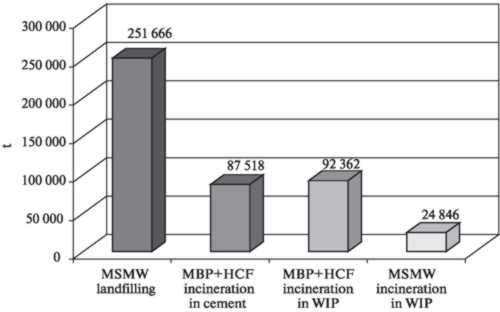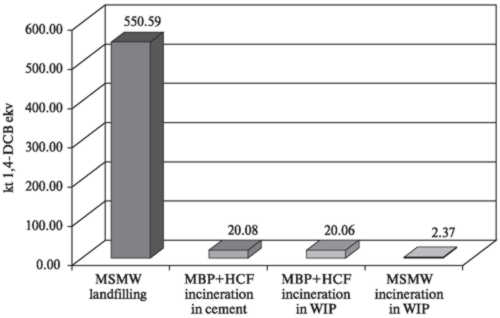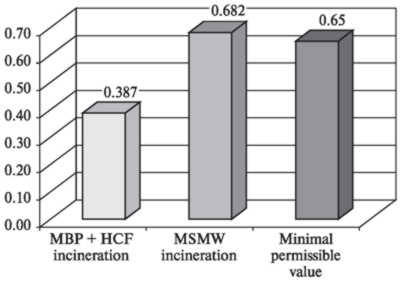
Energetic, Environmental and Economical Aspects of Solid Municipal Waste Treatment Alternatives in Vilnius Region, Lithuania: Incineration and/or Mechanical Biological Treatment
Denafas G.,
Buinevicius K.,
Kaunas University of
Technology, Kaunas, Lithuania
Petreikis R.,
JSC «Axis
Industries», Vilnius, Lithuania
Vaupsiene N.,
JSC «Akmenes cementas», Naujoji Akmene, Lithuania
Introduction
The
implementation of requirements of Council Directives 1999/31/EC (Landfill of
Waste) and 2001/77/EC (Promotion of Electricity Produced from Renewable
Sources in the Internal Electricity Market) is important for both Lithuania
and many other new EU members. The incineration of municipal solid mixed
waste (MSMW) can be one of possible means for realisation of these purposes.
The main MSMW disposal method in Lithuania still remains landfilling. It is
necessary to underline that already several years ago the Lithuanian
scientists tried to evaluate the municipal waste incineration feasibility
from the energetic and environmental points of view both for Lithuania in
general (Denafas, 2003) and for separate Lithuanian regions (Wade, 2006;
Rimaityte, 2006). However the Lithuanian government considered this
feasibility only after the entrance of Lithuania into EU and corresponding
obligations for fulfillment of the above mentioned directives. For this aim
the special pre-feasibility study has been prepared (Preparation, 2006).
This study gave the motive for private business representatives to construct
the waste incineration plant (WIP) in Lithuanian capital city Vilnius. But
this intention has lead to resistance of Vilnius inhabitants and opposition
of businessmen who planed to develop the MSMW mechanical-biological
pre-treatment (MBP). Therefore the aim of this publication is to present the
MBP and the incineration feasibilities for Vilnius waste management region
and to perform the corresponding environmental and energetic assessment. The
borders of Vilnius waste management region fully correspond to the borders
of Vilnius county (Fig. 1).

Fig. 1. Waste management regions in Lithuania
The assessment of MBP and incineration alternatives for Vilnius waste management region had been performed in concordance with information of the Lithuanian State Strategic waste management plan and considering the recommendations of EU specialists (Deliverable, 2003) where the separate collection and recycling of municipal waste fractions are expected to be: biowaste — 22 %; paper and cardboard — 60 %; plastics and composites — 25 %; glass — 60 %; metals — 50 %; other combustible waste (in fact — wood) — 3 %.
The prognosis of municipal
waste generation and content for Vilnius waste management region
The forecasts
for municipal generation have been performed using LCA-IWM (den Boer, 2005)
prognostic model (Fig. 2).

Fig. 2. Municipal waste generation forecast (2013, Vilnius waste management region, Lithuania)
Keeping in mind the proposed separate collection the MSMW should be predominant nevertheless (Fig. 3).

Fig. 3. Municipal waste collection forecast (2013, Vilnius waste management region, Lithuania)
The forecasted content of MSMW (with biowaste domination) is presented in the Fig. 4.

Fig. 4. Mixed municipal waste content forecast (2013, Vilnius waste management region, Lithuania)
The alternatives of MSMW management
Furthermore using the assessment model with the same LCA-IWM (den Boer,
2005) name some MSMW management alternatives have been assessed and compared
from energetic and environment points of view.
Zero alternative: MSMW landfilling
In this case the collected residual MSMW are landfilled.
1 alternative: MSMW mechanical-biological pre-treatment (MBP) and HCF incineration in cement kilns
In this case:
—
collected residual MSMW is treated mechanically with particular
metals separation and division into high calorific fraction (HCF) and low
calorific fraction (LCF);
—
separated metals go to recycling;
—
LCF is treated biologically and the content of biowaste is
significantly reduced;
—
HCF is incinerated in cement kilns;
—
stabilized LCF is landfilled.
2 alternative: MSMW mechanical-biologicalpre-treatment (MBP) and HCF incineration in WIP
In this case:
— collected residual MSMW is treated mechanically with particular metals separation and division into high calorific fraction (HCF) and low calorific fraction (LCF);
—
separated metals go to recycling;
—
LCF is treated biologically and the content of biowaste is
significantly reduced;
— HCF is incinerated in WIP with energy recovering, whereas 80 % of obtained slag is used for road building;
— stabilized LCF and rest slag are landfilled.
3 alternative:
MSMW incineration in WIP
In this case:
—
collected residual MSMW is incinerated in WIP with energy recovering;
— metals are separated from obtained slag and 80 % of slag is used for road building;
— the rest slag is landfilled.
The used LCA-IWM assessment tool evaluates chemical content, moisture and caloricity of every waste fraction, pollutant emissions of each waste treatment technology (Deliverable, 2003). The tool considers that the fire grate technology (as the best available technology) with effective gas cleaning system is used for waste incineration. The tool also considers the parts of waste fractions to be divided between HCF and LCF, the part of biowaste to be destroyed at the biological stage of MBP. The corresponding contents of HCF and stabilized LCF are presented in the Figs. 5 and 6.

Fig. 5. HCF content forecast (2013, Vilnius waste management region, Lithuania)

Fig. 6. Dry stabilized LCF content forecast (2013, Vilnius waste management region, Lithuania)
Assessment results
First of all we
review the differences of waste and/or waste treatment residue flows to
landfills for every alternative (Fig. 7). It is evident that:
—
due to MBP and following HCF incineration the municipal waste flow to
landfill is reduced 2.8 times;
—
due to MSMW incineration — 10.1 times.

Fig. 7. Waste or waste treatment residue flows to the landfill for MSMW treatment alternatives (2013, Vilnius waste management region, Lithuania)
It is necessary to bear in mind that namely biowaste coming to landfill with MSMW and/or its treatment residues cause most of environmental problems because the main amount of greenhouse gas (methane CH4) and toxic compounds are being emitted together with landfill gas and leachate during anaerobic biowaste digestion. The emissions of these environmental pollutants are significantly lower during waste incineration (considering gas cleaning efficiency). Figs. 8 and 9 clearly illustrate the advantages of MSMW incineration.

Fig. 8. Greenhouse gas emissions for MSMW treatment alternatives (2013, Vilnius waste management region, Lithuania)

Fig. 9. Human toxicity for MSMW treatment alternatives (2013, Vilnius waste management region, Lithuania)
The energetic assessment of investigated alternatives is characterized in the Fig. 10. According to energetic aspects the incineration is the best MSMW treatment method. This method satisfies the minimal requirements for energy recovery from waste according to not yet enforced new EU Waste Directive.

Fig. 10. Possible energy efficiencies for MSMW treatment alternatives (2013, Vilnius waste management region, Lithuania)
The economic assessment of considered alternatives is characterized in the Fig. 11.

Fig. 11. Possible investment, operating and overall costs for MSMW treatment alternatives (2013, Vilnius waste management region, Lithuania)
In that way the operating costs for MSMW incineration in the WIP are almost 2 times lower than for MBP. However the corresponding investment costs are about 3 times higher. The costs for exploitation of cement kiln during HCF incineration in the already functioning Lithuanian cement production facility are excluded.
Conclusions
The performed assessment for Vilnius waste management region in
Lithuania shows that:
• In case of MBP process for MSMW and subsequent HCF incineration the
municipal waste flow to landfill is reduced 2.8 times, whereas in case of
MSMW incineration — 10.1 times;
• In case of MBP process and subsequent HCF incineration for MSMW the
biowaste flow to landfill is reduced 5—6 times, whereas in case of MSMW
incineration the biowaste flow to landfill is excluded;
• In comparison to MSMW landfilling the MBP process with subsequent HCF
incineration reduces greenhouse gas emissions 8.6 times, MSMW incineration —
10.4 times;
• In comparison to MSMW landfilling the MBP process and subsequent HCF
incineration reduces the human toxicity 27 times, MSMW incineration — 232
times;
• Energy efficiency for MBP and subsequent HCF incineration is 38 %, MSMW
incineration — 68 %, whereas according to new EU Waste Directive this
efficiency must be not less than 65 %.
In comparison to MBP the economic advantages of MSMW incineration are evident considering operating costs, however the corresponding investment costs for incineration in WIP are about 3 times higher.
Денафас Г., Буйнявичус
K., Каунасский технологический университет, Каунас, ЛитваСогласно требованиям стратегического плана Литвы по управлению отходами, для Вильнюсского региона проведена сравнительная оценка сжигания и механико-биологической обработки смешанных коммунальных отходов (СКО), которые составят около 65 % общего объема образующихся коммунальных отходов (35 % предусматривается собирать раздельно). В качестве инструмента прогнозирования количества отходов использована программа
LCA-IWM.В ходе анализа установлено, что с энергетической и экологической точек зрения сжигание СКО предпочтительнее, чем их механико-биологическая обработка с последующим сжиганием фракции высокой калорийности. Отмечается, что только при сжигании СКО удовлетворяются требования по энергетической эффективности, изложенные в директиве ЕС об отходах.
Denafas
Gintaras, Dr,
docent, Department of Environmental Engineering, Kaunas University of
Technology, Radvilenii
av. 19, Kaunas,
LT-50254, Lithuania. Tel. (37) 30-01-83, fax (37) 30-01-52.
E-mail
Buinevicius
Kestutis, Dr,
docent, Department of Thermal and Nuclear Energy, Kaunas University of
Technology, Donelaicio
str. 20, Kaunas, LT-44312, Lithuania. Tel./fax (37) 30-04-41.
E-mail
Petreikis Raimondas,
head of Technologies
Department Division, JSC «Axis Industries»,
Smolensko str. 12, Vilnius, LT-03201, Lithuania. Tel. (5) 239-49-49.
E-mail
Vaupsiene Nijole,
quality manager, SC «Akmenes
cementas», J. Dalinkeviciaus
str. 2, Naujoji Akmene,
LT-85118, Lithuania.
Tel. (425) 5-84-97. E-mail
© Последние изменения внесены 02.10.09
© EcoInform